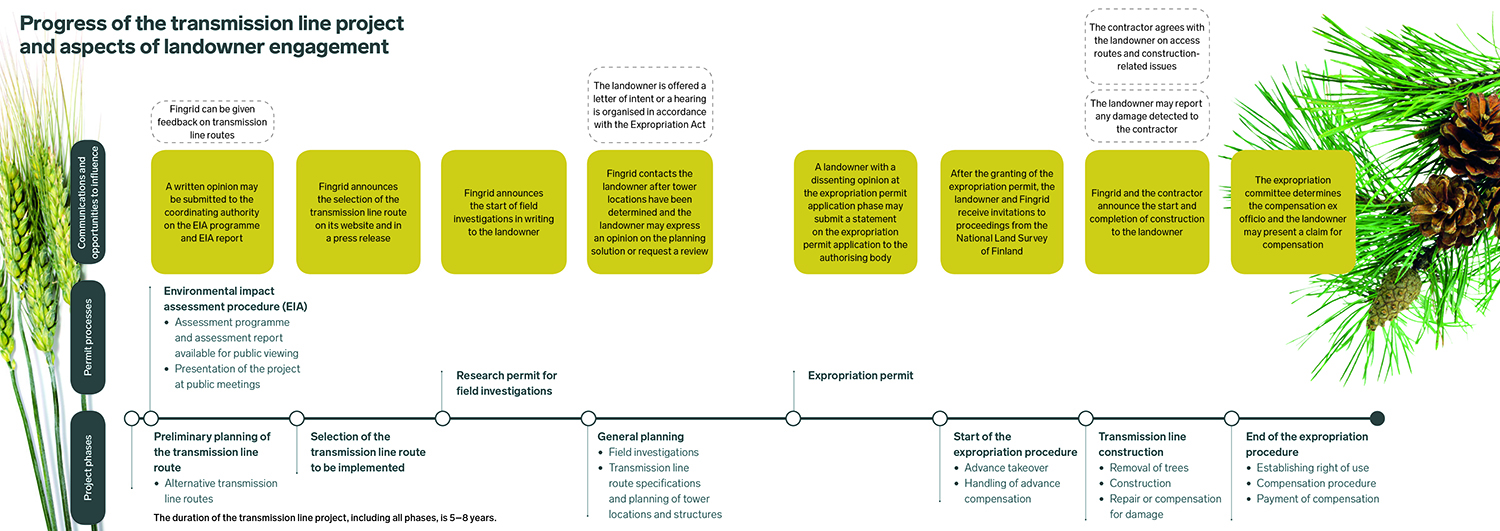Preliminary planning involves studying the potential routing options for transmission lines. The route is influenced by factors such as technical feasibility, environmental matters, settlements, historical values and land use plans.
Take a look at the Progress of the transmission line project and aspects of landowner engagement.
Environmental Impact Assessment (EIA)
EIAs identify the environmental impacts of a project and the options available for mitigating them. The EIA competent authority extensively consults with other authorities, associations, local residents and landowners. Fingrid decides on the specific transmission line route with the help of the information provided by the EIA.
Landowners and other parties with an interest in the project have the opportunity to influence the choice of route during the EIA consultations by submitting a written opinion to the competent authority. Fingrid acts as the party responsible for the EIA project. In this capacity, Fingrid participates in public consultations, distributes information and sends invitations to public EIA events in many ways, such as by post and by newspaper notifications. The public can also send comments using the electronic feedback system on Fingrid’s website.
General planning phase
The general planning phase involves planning the final transmission line route and tower locations based on soil investigation. Landowners can present their opinions on the design decisions or request reviews. The landowners’ letter includes the contact details of the contractor and the Fingrid personnel in charge of the work, and it asks landowners to provide their email addresses and phone numbers. Information is also offered on the map service and the project-specific website.
Expropriation procedure
provides right of use
Fingrid uses an expropriation procedure to obtain the right of use for the transmission line area. Before applying for an expropriation permit, Fingrid tries to obtain the landowner’s consent for the transmission line route.
The Ministry of Economic Affairs and Employment, which processes the application, requests the necessary opinions from the authorities, municipalities and the interested parties who have not granted their consent. A consultation is arranged. The expropriation permit is issued by the Council of State, and it can be appealed at the Supreme Administrative Court.
The interested parties are invited to the initial proceedings related to the expropriation procedure by letter. The initial proceedings cover matters such as the compensation procedure. Fingrid does not have a representative on the expropriation committee, nor is Fingrid involved in deciding on compensation.
Construction phase
and final feedback
Fingrid and the contractor inform the landowners of the commencement of construction, and the contractor makes agreements with them concerning all traffic on private roads through fields and yards. They are given an opportunity to present a claim for compensation to the expropriation committee.
When the transmission line is completed, agreements are made at the follow-up meeting on the date for submitting compensation claims and terrain reviews. At the final proceedings, the expropriation committee issues a compensation decision and the grounds for the decision. Fingrid conducts feedback surveys when transmission lines are completed in order to improve its operating methods.
Example of communication: Huittinen–Forssa 400 + 110 kV transmission line
Numerous letters to contact landowners
Fingrid aims to actively communicate with landowners on how they can make their voices heard. The law only requires Fingrid to provide notification in a newspaper, but Fingrid chooses to go beyond this requirement.
“Fingrid sent notices to more than 400 landowners on the public events related to the EIA procedure for the Huittinen–Forssa transmission line project. The events were held in September. We also advertised the event in four newspapers. However, a personal letter is a more effective way of reaching the correct person. Several of Fingrid’s specialists attend public events, and participants have the best chance of influencing decisions at the early stages of the project,” says Ilkka Alm, Fingrid’s Land Use Manager.
Fingrid sends a total of more than 10,000 landowner letters every year. They include information on matters such as the transmission line projects in progress, expropriation procedures, compensation payments and vegetation management in transmission line areas. If necessary, the letters include contact information and may also request the recipient’s contact details in order to provide more detailed and up-to-date information by means such as email or text message.







